-
don’t dead-head those finch feeders!
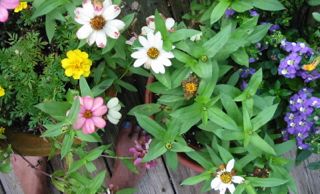 The only good thing about standing at the sink is catching the bird action on the deck! At present there’s five hummingbird feeders, two bird baths, and an open tray feeder… which squirrels usually hog. And flowers-gotta have plants and color to complete the scenery.
The only good thing about standing at the sink is catching the bird action on the deck! At present there’s five hummingbird feeders, two bird baths, and an open tray feeder… which squirrels usually hog. And flowers-gotta have plants and color to complete the scenery.Hearing a rustling noise, and seeing movement in those flowers from the corner of my eye, it deserved a closer look. There were two goldfinches feeding and flitting amongst the zinnias. It was pretty cool and well worth a photo, so out on the deck I went with camera in hand. Well, the electric yellow birds didn’t make the shot… but my blue toes did 🙁
In fall, spent flowers like zinnia, coneflower, sunflower… and lots of others with seed heads provide a bounty of food for wild birds. They’re actually nature’s finch feeders. So next time you have the urge to dead-head those spent blooms… don’t! Leave them a while longer so they can do what nature intended… feed the birds.
I never did get close enough for the intended photo… but at least a better shot sans the fee
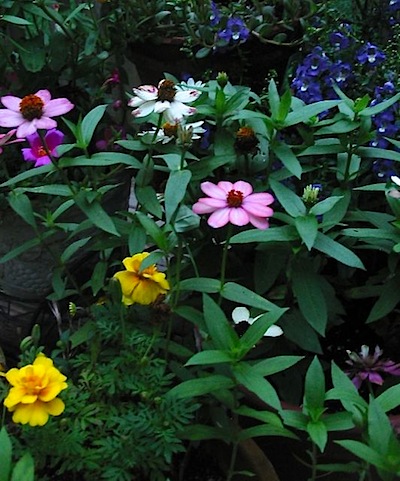 t!
t! -
What’s all the frenzy around your tube bird feeder?
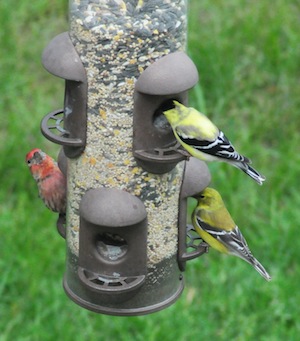 Several fellow birders have noticed an increase in activity at feeders recently. A few guesses were about the wet season and lush plant growth, possibly providing fewer seeds than usual for this time of year. One person writes: “Finches, Cardinals, Chickadees, Tufted Titmice, White-breasted Nuthatches, and more have increased their activity at my tube bird feeder significantly, even fighting each other. I was filling the feeder once a week, but the birds are emptying it daily.”
Several fellow birders have noticed an increase in activity at feeders recently. A few guesses were about the wet season and lush plant growth, possibly providing fewer seeds than usual for this time of year. One person writes: “Finches, Cardinals, Chickadees, Tufted Titmice, White-breasted Nuthatches, and more have increased their activity at my tube bird feeder significantly, even fighting each other. I was filling the feeder once a week, but the birds are emptying it daily.”So what’s the reason behind the increased activity? Because many species are molting their feathers right now, they have an increased need for a steady diet of high quality food. Chickadees, titmice, nuthatches and others are kicking into high gear with hoarding seeds right now too. If you watch some of these birds closely, you’ll see them eating some of the seeds but they will be stashing many more of them under the bark of older trees, and or poking them into holes and cracks in trees and other locations.
Your location plays a role as well. “This is actually the time of the year when there is the highest number of plants that are producing seeds, mast and or fruit out in forests, fields and “weedy” pasture lands. City lawns and evergreen landscaping and ornamental landscape trees often do not produce any seed type food for wildlife at this time of the year. So it might depend on your particular location as to how much food is available for each of these different species.”
Seeing empty feeders just goes against our grain 🙁 If birds’ activity has increased at your feeder that it takes filling everyday… it may be a good time for a bigger one? Winter’s not too far off and these resilient resident birds are sure to hang around a dependable food source.
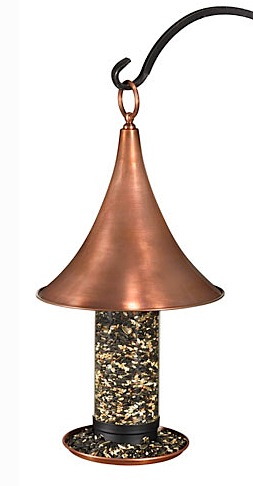
This new tube feeder’s a beauty too! At a whopping two feet tall, the large Castella features a venetian bronze finish over steel, with a seed tray for less waste and easy perching. And the killer turret… it adds a magical touch to any garden setting!
-
More eating and less fighting with Bird Brain hummingbird feeders
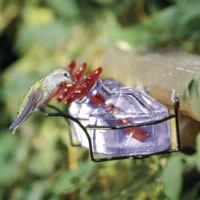 Their migration south will soon begin as will the “crazies”! Mobs of them, buzzing, fighting, darting around feeders to stake their claim. Tiny bodies need lots of energy for the trek back to winter breeding grounds in Central and South America, and it’s big attitude when it come to fueling up for the trip. Territorial would be an understatement, the sprites can become pretty fierce and downright possessed around feeders!
Their migration south will soon begin as will the “crazies”! Mobs of them, buzzing, fighting, darting around feeders to stake their claim. Tiny bodies need lots of energy for the trek back to winter breeding grounds in Central and South America, and it’s big attitude when it come to fueling up for the trip. Territorial would be an understatement, the sprites can become pretty fierce and downright possessed around feeders!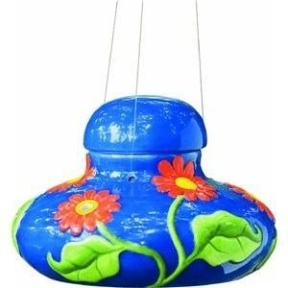
It’s been a weird season for hummingbirds, many folks report fewer numbers upon their initial arrival, the extended winter weather likely to blame. Fewer (almost none) of the birds’ natural nectar sources were available for their journey northward, possibly causing many to perish. It wasn’t until much later in the season we started seeing more numbers at feeders… and many of them being juveniles.
And soon again it will be time to go – the dwindling hours of daylight is what signals their clocks that it’s time. It’s a total myth that leaving feeders out will keep hummingbirds from leaving… Mother Nature tells them otherwise.
You can really make a difference in helping these flying jewels by offering as much food, and as many sources as possible. If you haven’t done so in the past, try making your own nectar before the season’s over (you’ll be glad you did). It’s really so very simple: 1 cup plain table sugar to 4 cups water… that’s it! Nothing else in the solution as it’s harmful, no red dye needed. We boil one cup of water just to dissolve the sugar more effectively – add 3 cups of cold and no waiting for it to cool. Store unused nectar in the fridge for up to two weeks. Some say the solution may be made stronger during migration as more sugar equals more fuel. Never stronger than a 1:3 ratio though.
Keep nectar fresh and consider hanging an
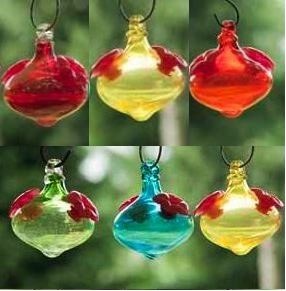 extra feeder or two so there’s not so much fussing and fighting. Multi-port styles are a good idea as they allow more birds to feed at once… provided they can all get along!
extra feeder or two so there’s not so much fussing and fighting. Multi-port styles are a good idea as they allow more birds to feed at once… provided they can all get along!Most of the Bird Brain Hummingbird Feeders offer 2-3 ports and some of them are still around. In fact, they’re being manufactured again under a different name – so they must be worth it! The Mini-kins are perfect for this time of year because they come in a set of three and may be placed in separate locations. Again… less fussing and more eating will suit hummingbirds best for their long trip ahead!
